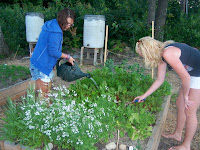 Countertop Pickles...They Came Out Great!
Countertop Pickles...They Came Out Great!In the jar are pickling cukes, garlic cloves, shallot bulbs, and dill heads as well as salted water and white vinegar. What you do is fill the very clean jar with cukes. Then add a few cloves of garlic, shallots, and dill heads. In a separate jar mix 1 TBSP canning salt into 1 quart of water. 1/2 fill the jar with this salty water mixture. Then fill the rest of the way with the white vinegar. If you need more salty water be sure that its a mixture of 1 TBSP in 1 quart of water. Use that salty water mixture even if you only use a little of it. Be sure all contents are covered with liquid. You should have approximately 1/2 salty water and 1/2 vinegar.Cover the jar and let it sit out of sunlight on your counter. DO NOT SEAL TIGHTLY!!!! Let top sit lightly on top so gasses can escape. Let it sit on the counter for a few days. Watch how the cukes change from looking like cukes to looking like pickles. After 2 days I tasted and they were mouth puckering, way too vinegary! But I didn't do anything. I just let them sit a few more days. Then tasted on day 5 and it was good for me. I clipped on the lid and put them in refrig. Now is one month later and they are delicious! When you put them in the refrig you slow down the fermentation process so you want them to taste the way you like them before you put them in the refrigerator. But I did notice that they mellowed and became real pickles as the month progressed.
(Note: it is 4 years later and I just found another idea from The Old Farmer's Almanac to try. After the rain tonight I'm going to look for small veggies, including pickling cukes, to try this with. "Every couple of weeks, I made a fresh brine—half cider vinegar, half tap water—filling the crock two-thirds full. I’d add three or four dill heads, a few peeled garlic cloves, and a little pickling salt. Then I’d start adding vegetables, usually weighing them down into the brine with a small plate."
Now that we have that out of the way let's begin our post....What do you do when you have more tomatoes, summer squash, zucchini,cucumbers, scallions, than you know what to do with? You go on a mini vacation! Well not usually but that's what we did. But then you come back and you either share or you can put them up. Or maybe you do both.
We came back from a wonderful mini vacation visiting the western Maine mountains and hearing the Wailin Jenny's. If you have not listened to them, you must! They are so talented; 3 young woman (and 1 is from Maine!) and now a young man. The four of them play a variety of string instruments as well as a few others. But it's their voices that are so phenomenal. What is it about some music that just reaches right into your soul and rips it out?! Well that's them. They have a sound that is not only beautiful but it reaches to the depth of your soul. They are angelic and listening to them in the most beautiful and acoustically amazing barn there is just sets the backdrop for a wonderful and sensual evening. We saw them at Stone Mt. Performing Arts Center in Brownfield Maine. Here is a photo of SMAC:
 The music happens in the red barn to the back. The owners live in the farmhouse in the front
The music happens in the red barn to the back. The owners live in the farmhouse in the frontAnd here is SMAC's website: http://www.stonemountainartscenter.com/ArtsCenter/
And here is the Wailin Jenny's website: http://www.thewailinjennys.com/home.aspx
The Inn at Crystal Lake is the closest inn to stay at. It's really nice. Not too foo foo if you know what I mean. I've stayed in inns before that are down right gaudy. Some rooms look like they came out of a doll house. What man wants to stay in a pink and lacy room!? I don't get it. But this one is nice, run by nice guys, in a real nice location (request a back room) and great food. Well to be honest there is a small B&B closer to SMAC and we stayed there last winter and we froze our buns off! No heat upstairs! I know here in Maine we can be a hardy group of souls and many, including us, do not have heat upstairs (it's just the way old farmhouses were built), but when you pay to go somewhere; I'm sorry I want heat! So we don't go there anymore. We are now Crystal Lake converts. Here's a pic of the inn's front porch (which by the way is not the inn's best feature!) I really enjoyed sitting out back.

Today I am going to make relish with my cucumbers, can more tomatoes, and try to get some local peaches to make peach butter. I'll post pictures and recipes when I'm done. Note to self - next year plant pickling cukes so I can make pickles!
Enjoy your garden's produce! And remember to replant whenever your crop is spent.
Mary
PS - Almost forgot to mention that I came back to a garden full of powdery mildew. Pumpkins have it the most; the leaves look like they are covered with a powdery substance. Here's info on dealing with it. But to be honest I'm just not going to deal with it. I think I'll still get all my pumpkins just fine. It just looks awful. http://www.organicgardening.com/feature/0,7518,s1-2-73-894-1-4-2,00.html
































